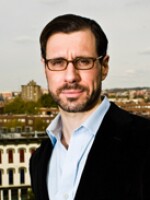Fifty years ago this summer, more than 2 million people thronged to a leafy park in Moscow, where a set of newly constructed, futuristic-looking pavilions brimmed with the latest American consumer goods.
It was barely six years after dictator Josef Stalin's death ended the worst Soviet repressions. Braving a broiling summer sun, the Soviets gawked at Polaroid cameras, the latest washing machines and a model house.
The 1959 American exhibition in Moscow was an iconic episode of detente, one of the many instances of rapprochement that came between the shoe-thumping and nuclear brinksmanship of the Cold War. The exhibition also has special significance for me.
It was meant to blow Soviet minds into accepting the superiority of capitalism over communism. On opening day, then-Vice President Richard Nixon escorted Soviet leader Nikita Khrushchev through the pavilions. Reaching a model kitchen, they stopped in front of surprised onlookers and faced each other in what would be known as the Kitchen Debate.
Nixon suggested to the portly, combative Khrushchev that the United States was ahead of the Soviet Union in some areas. He used as an example the development of color videotape being used to record their meeting.
"This indicates the possibilities of increasing communication," he said, "and this increasing communication will teach us some things, and it will teach you some things, too. Because, after all, you don't know everything."
Khrushchev wasn't having any of it. The Soviets were ahead in most areas, he insisted, and anyway, the video would probably be used for propaganda back in the United States. "What I have to say is being translated only into your ear," he said, "but the American people will never hear it."
It almost seemed Khrushchev had spent his entire political life preparing for that opportunity to demolish the apparent benefits of capitalism. But at the time, most Americans believed Nixon won the debate.
One Couple Bridges The Divide
For many of the young Americans serving as guides at the exhibition, however, the major interest was their once-in-a-lifetime opportunity to experience the Soviet Union, a state portrayed back home as their mortal enemy.
One of the guides was my father, George Feifer. He was stationed next to a Ford Thunderbird during the exhibition, but says he found himself spending far less time answering questions about the car than about the American school system and other aspects of American life.
"There was this great sea of affection for the American people," he says. "There was also among these supposedly downtrodden and oppressed peoples, as we incessantly were told, a great deal of humanity and originality and humor."
At the front gates, visitors stood in line for hours to get into the exhibition, where many got their first taste of Pepsi-Cola. One of the visitors was a 16-year-old Muscovite named Tatyana Stepanova. She's also my mother. She says the most crowded displays were those where the American guides spoke freely and with a sense of humor.
"I just somehow sensed how free that country was," she says. "Through their gestures, through the way they behaved, through the way they were dressed. You just could see that these were free people, and we were not."
At the Ford display, my future mother asked my future dad a question about American jazz that he was unable to answer. But he got her to return the next day by giving her one of the most craved items in Moscow that summer: an exhibition pass that meant she wouldn't have to line up again. They eventually married, and she left the Soviet Union.
Personal Connections Powerful, But Not Enough
My father, a journalist, spent years writing about Russia. Some of the other guides went on to become editors, scholars and diplomats. The current American ambassador to Russia, John Beyrle, was a college student when he got his first guide job at a later exhibition in 1977. He says the exhibitions gave millions of Soviets a chance to hear young Americans speaking without Soviet censorship.
"The impact it had on pushing back against some of the worst anti-American propaganda pushed by the Soviet Union in those days is hard to calculate," he says. "But I know that it had an effect on a lot of people, because I've met some of these people now coming back as ambassador."
Still, Beyrle says the exhibitions also showed the limits of personal connections. He believes they can't overcome profound misunderstandings between the two cultures. Today, most observers say the level of hostility and distrust toward America and Americans among ordinary Russians is much stronger than it was when Nixon debated Khrushchev 50 years ago.
Whatever the limits of cultural diplomacy, the participants in the American exhibitions believe they can be a useful model for President Obama as he seeks to improve ties with Moscow. Those personal contacts between ordinary Americans and Russians even during the bitter days of the Cold War benefited U.S. foreign policy, not to mention this radio correspondent.
Copyright 2022 NPR. To see more, visit https://www.npr.org. 9(MDAzMjM2NDYzMDEyMzc1Njk5NjAxNzY3OQ001))






